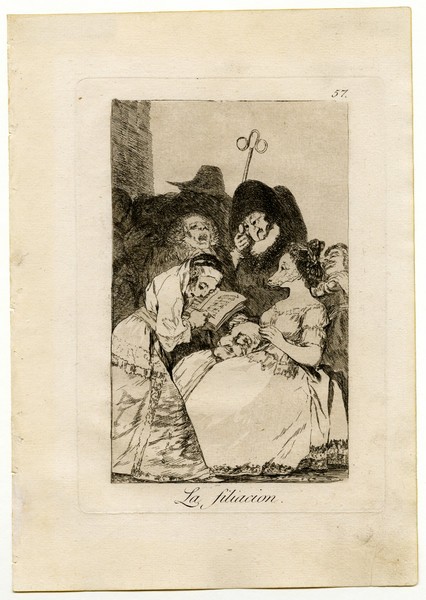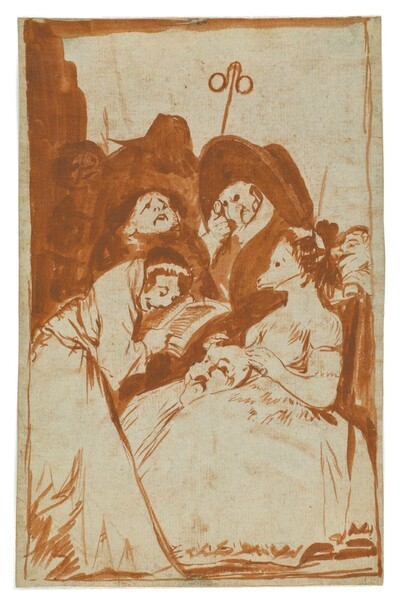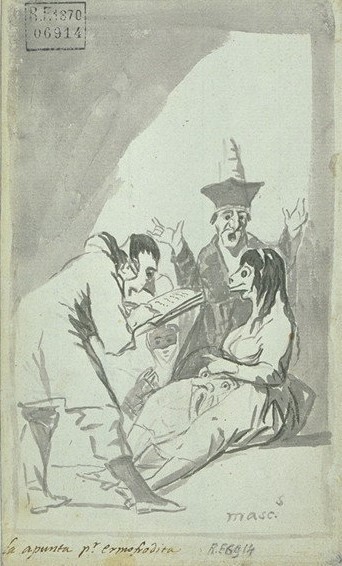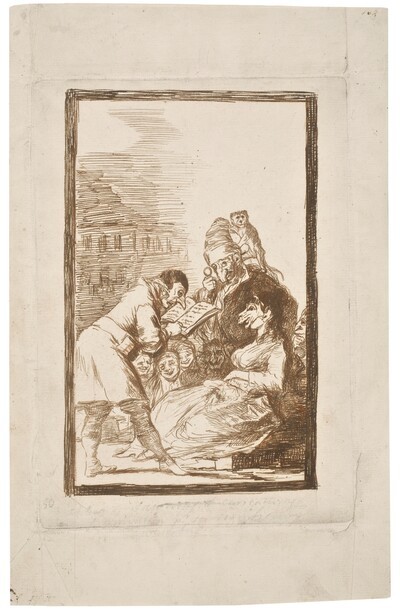- Cronología
- Ca. 1797 - 1799
- Dimensiones
- 217 x 152 mm
- Técnica y soporte
- Etching and aquatint
- Reconocimiento de la autoría de Goya
- Undisputed work
- Ficha: realización/revisión
- 26 Dec 2010 / 29 May 2024
- Inventario
- 225
La filiacion. (at the bottom)
57. (in the upper right-hand corner)
See Francisco de Goya y Lucientes, Painter.
There are two state proofs before the letter and after the aquatint.
Three preparatory drawings of this engraving have survived (1), (2) and (3) .
A seated woman in profile in the foreground wears a fox's mask over her face and a grotesque mask on her lap. In front of her, a priest or a woman - the identity of this personage is unclear - is verifying the executor's certificate attesting to the young woman's lineage. It seems that she is going to marry the figure standing next to her in the background, although it could also be a bailiff who is checking that the act is going well. The latter has a deformed face with a long, ostentatious nose, and adjusts a pair of glasses to see better. On the right of the engraving is a rapt figure with clasped hands, and on the left is a crowd, a dehumanised mass that is mostly undefined. The light is concentrated on the two figures in the foreground, while the rest are practically unilluminated, which accentuates the idea of indefiniteness.
The manuscripts agree that this is the moment before a marriage in which the bride's origins are being explained to her future husband. In the Biblioteca Nacional manuscript, the significance of the glasses, which are placed high up in the centre of the composition, is specified. They are used to see what is near, that is to say, to look more closely at things, overcoming all appearances.
The bride wears a fox mask over her face which, as in many other cases of Goya's use of masks, reveals the woman's true identity, rather than concealing it as one might think.
A careful analysis of the preparatory drawings will help us to understand how Goya's work evolved until he arrived at the present engraving. In the first drawing, which is the one in the Madrid Album, the mask between her legs has clear sexual connotations that could be an allusion to the young woman's possible hermaphroditism. Goya gradually modified this object until it became a grotesque mask without such explicit sexual connotations.
The plate is preserved in the National Chalcography (no. 228).
-
Goya. Gemälde Zeichnungen. Graphik. TapisserienKunsthalle BaselBasle1953from January 23th to April 12th 1953cat. 242
-
De grafiek van GoyaRijksmuseum RijksprentenkabinetAmsterdam1970from November 13th 1970 to January 17th 1971cat. 42
-
Goya. Das Zeitalter der Revolucionen. Kunst um 1800 (1980 – 1981)Hamburger KunsthalleHamburg1980cat. 48
-
Goya dans les collections suissesFundación Pierre GianaddaMartigny1982consultant editor Pierre Gassier. From June 12th to August 29th 1982cat. 41
-
Goya. La década de Los CaprichosMadrid1992organized by Real Academia de Bellas Artes de San Fernando sponsored by Fundación Central Hispano, Madrid, consultant editor Nigel Glendinnig. From October 26th 1992 to January 10th 1993cat. 43
-
Francisco de GoyaMuseo d'Arte ModernaLugano1996exhibition celebrated from September 22nd to November 17th.cat. 57, p.84
-
Francisco Goya. Sein leben im spiegel der graphik. Fuendetodos 1746-1828 Bordeaux. 1746-1996Galerie KornfeldBern1996from November 21st 1996 to January 1997cat. 63
-
Goya e la tradizione italianaFondazione Magnani RoccaMamiano di Traversetolo (Parma)2006consultant editors Fred Licht and Simona Tosini Pizzetti. From September 9th to December 3th 2006cat. 57, p.160
-
Goya. Opera graficaPinacoteca del Castello di San GiorgioLegnano2006exhibition celebrated from December 16th 2006 to April 1st 2007p.39
-
Goya et la modernitéPinacothèque de ParisParís2013from October 11st 2013 to March 16th 2014cat. 135
-
Expérience GoyaLille2021cat. 48
-
2022
-
Goya engravings and lithographs, vol. I y II.OxfordBruno Cassirer1964p.132, cat. 92
-
Vie et ouvre de Francisco de GoyaParísOffice du livre1970p.183, cat. 565
-
Goya, la década de los caprichos: dibujos y aguafuertesMadridReal Academia de Bellas Artes de San Fernando1992pp.67-71, cat. 40-43
-
Catálogo de las estampas de Goya en la Biblioteca NacionalMadridMinisterio de Educación y Cultura, Biblioteca Nacional1996p.103, cat. 146
-
El libro de los caprichos: dos siglos de interpretaciones (1799-1999). Catálogo de los dibujos, pruebas de estado, láminas de cobre y estampas de la primera ediciónMadridMuseo Nacional del Prado1999pp.298-301
-
ParísPinacoteca de París2013p. 196
-
Goya. In the Norton Simon MuseumPasadenaNorton Simon Museum2016pp. 42-75
-
Expérience Goya (cat. expo)LilleRéunion des Musées Nationaux2021p. 94
-
Museo de Bellas Artes de Badajoz y Diputación de Badajoz2022p. 45



